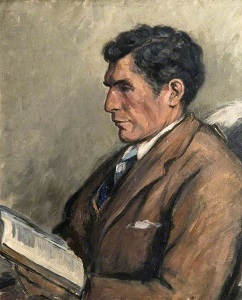De Welshe dichter en schrijver John Cowper Powys werd geboren op 8 oktober 1872 in Shirley, Derbyshire. Hij schreef gedichten, essays, romans en uitgebreide filosofische geschriften. Tussen 1915 en 1957 publiceerde hij bijna elk jaar een van zijn omvangrijke boeken.Powys was een uitgesproken polytheïst en tegelijk overtuigd agnost, op zoek naar poëtische en niet naar geestelijke zin. Powys ‘vader was dominee in Derbyshire. Zijn moeder was een afstammeling van de dichter William Cowper, waaraan hij zijn middelste naam dankt. Hij was de oudste zoon van een hele familie van kunstenaars. Zijn twee broers Llewelyn Powys en Theodore Francis Powys waren bekende schrijvers in hun tijd. Zijn zus Gertrude was schilderes en zijn zus Philippa was eveneens schrijfster. Hij bracht zijn jeugd door in het dorpje Montacute in Somerset. Deze zuidelijke Engels platteland vormde later de geografische achtergrond van zijn romans. Powys bezocht het internaat Sherborne School en studeerde aan de Universiteit van Corpus Christi (Cambridge) geschiedenis. Op 24-jarige leeftijd publiceerde hij “Odes and Other Poems”. Voordat hij aanhet begin van de eeuw met literaire lezingen zijn levensonderhoud verdiende werkte hij als leraar in Sussex. In 1896 trouwde hij met Margaret Alice met wie hij een zoon had. Na de scheiding van het paar bleef hij haar echter steunen tot aan haar dood in 1947. Zijn zoon Littleton werd Anglicaans priester. John Cowper Powys ondernam uitgebreide en succesvolle lezingentournees – eerst in Engeland, daarna in continentaal Europa en tot slot in de VS, waar hij woonde van 1904 tot1934. Ook nam Powys deel aan herhaalde publieke debatten – legendarisch zijn zijn gesprekken met GK Chesterton en George Bernard Shaw. In het proces wegens vermeende obsceniteit van de roman Ulysses van James Joyce, trad hij – ondanks zijn afkeer van de Ierse schrijver – als verdediger op. Nadat Powys zich in 1929 had teruggetrokken naar Columbia County ten noorden van New York, schreef hij daar in de kortste tijd en op latere leeftijd zijn meest succesvolle romans “Wolf Solent”, “Glastonbury Romance” en “Weymouth Sands”. Op 1 juni 1929 begon hij op zijn jaarlijkse reis naar Europa met het schrijven van een dagboek, dat van meet af aan bedoeld was voor de publicatie. Het heeft betrekking op de periode tot 1939, en dus de meest productieve periode van zijn leven. De originele Engels titel “Petrushka and the Dancer” verwijst naar het ballet van Stravinsky. In augustus 1933 begon hij met zijn meer dan 700 pagina’s tellendeautobiografie, die hij in mei 1934 afrondde. Na het voltooien van zijn autobiografie, keerde hij met Phyllis Playter naar Engeland tewrug. De laatste 9 jaar van zijn leven tot aan zijn dood in 1963 bracht hij met zijn partner in Blaenau Ffestiniog door.. Powys’grote werken “Glastonbury Romance” en “Porius” behoren tot de monumentale werken van hedendaagse literatuur en worden vergeleken met “Ulysses” van James Joyce, Robert Musils Der Mann ohne Eigenschaften” of Prousts “À la recherche du temps perdu”.
Uit: A Glastonbury Romance
“Mr Evans had, as a matter of fact, been caught up into a region of feeling utterly beyond the comprehension of any Latin or any Teutonic mind. This had gone on since he stood before Pilate until the moment when he shouted “Eloi, Eloi!” It was not, as St Paul has put it so well – he the one among them all who would
really have understood Mr Evans – it was not with flesh and blood that he was contending, but with mysterious powers of evil upon levels revealed to few. No equivocal perversity gratified by divining the feelings of Persephone entered for a second into the terrible visions with which, as he hung between heaven and earth, his mind was bruised and broken . . . It was the prolongation of the scene – drawn out so foolishly, by that luckless Dance of Death of the two Marys – that had brought about his collapse, and it was the strain on his arms, bound too tightly by those ropes, and the tension of the muscles of his shoulders, stretched between the cross-bars, that had caused him such anguish. But not since the bloody King put the last Abbot of Glastonbury to death had such physical pain been experienced by anyone upon the slopes of Gwyn-ap-Nud’s hill. But it would be a mistake to say that the spirit of Mr Evans yielded, or weakened, or regretted his undertaking. Right up to the end, till by straining his torso to the breaking-point he had lost consciousness, he not only endured this anguish but he exulted in enduring it. His exultation kept mounting and mounting – extreme pain and ecstatic triumph embracing each other in dark mystic copulation.
Mr Evans became indeed Three Persons as he hung on his self-imposed cross. One person was his body, another was his soul. He felt his soul – or rather his soul felt itself – to be entirely outside of his body. This phenomenon was to him, as he hung alone there, looking down on that vast crowd, as much of a definite, concrete experience as the pain itself. The pain became a Third Person, and the soul of Mr Evans kept urging on the pain. He felt as if that crowd beneath him was the whole human race and that by the transaction that was now proceeding between these Three Persons, thus suspended in the air above them, this crowd, an immense animal passivity, was in some way re-created, purged, cleansed, transformed. His body, as the pain increased – as his soul deliberately caused the pain to increase – began to overbrim the confines of its human shape. His body projected itself under the pain in great waves of filmy chemical substance. It flung forth this filmy substance in streams, in torrents, in a mighty, rushing rain!”

John Cowper Powys (8 oktober 1872 – 17 juni 1963)
Portret door Gertrude Mary Powys, begin jaren 1930
